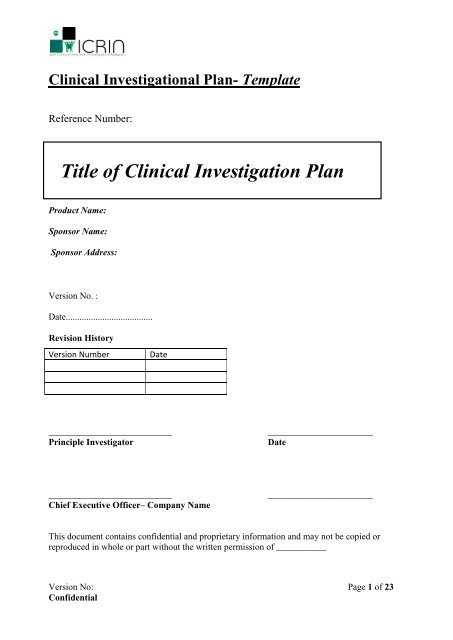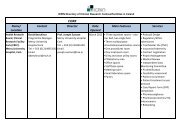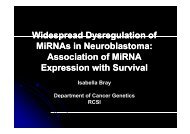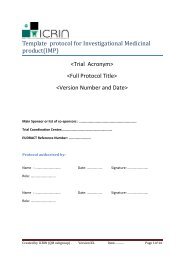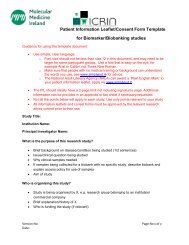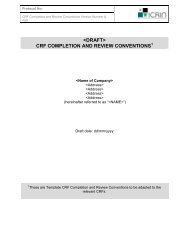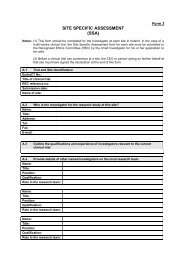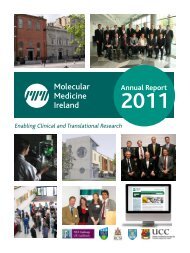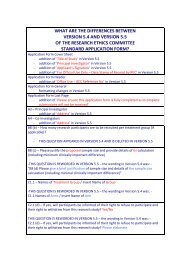Clinical Investigation Protocol Template - Molecular Medicine Ireland
Clinical Investigation Protocol Template - Molecular Medicine Ireland
Clinical Investigation Protocol Template - Molecular Medicine Ireland
You also want an ePaper? Increase the reach of your titles
YUMPU automatically turns print PDFs into web optimized ePapers that Google loves.
<strong>Clinical</strong> <strong>Investigation</strong>al Plan- <strong>Template</strong><br />
Reference Number:<br />
Title of <strong>Clinical</strong> <strong>Investigation</strong> Plan<br />
Product Name:<br />
Sponsor Name:<br />
Sponsor Address:<br />
Version No. :<br />
Date......................................<br />
Revision History<br />
Version Number<br />
Date<br />
___________________________<br />
Principle Investigator<br />
_______________________<br />
Date<br />
___________________________<br />
Chief Executive Officer– Company Name<br />
_______________________<br />
This document contains confidential and proprietary information and may not be copied or<br />
reproduced in whole or part without the written permission of ___________<br />
Version No: Page 1 of 23<br />
Confidential
<strong>Clinical</strong> Agreement Signature Log<br />
I, the undersigned, have read and understand the specific <strong>Clinical</strong> <strong>Investigation</strong> Plan, and agree<br />
with the contents. The <strong>Clinical</strong> <strong>Investigation</strong> Plan, the Investigator’s Agreements and any<br />
additional information provided by the sponsor will serve as a basis for co-operation in the<br />
study.<br />
I agree to conduct in person or to supervise the study.<br />
I agree to ensure that all who assist me in the conduct of the study have access to the study CIP<br />
plus any amendments and are aware of their obligations.<br />
Site Principle Investigator:<br />
_________________________ ________________________ ______________<br />
Name Signature Date<br />
___________________________________________________________________________<br />
Institution<br />
Name and address and professional position of:<br />
Name and address of principal investor<br />
Coordinator Investigator, if appointed<br />
Name and address of other investigation site(s) in which the clinical investigation will be<br />
conducted.<br />
Version No: Page 2 of 23<br />
Confidential
<strong>Clinical</strong> <strong>Investigation</strong> Summary<br />
Title<br />
<strong>Investigation</strong>al Medical<br />
Device<br />
Test and (comparator, if<br />
appropriate):<br />
Study Objectives:<br />
Study Design:<br />
Inclusion/<br />
Exclusion Criteria:<br />
Inclusion Criteria:<br />
Exclusion Criteria:<br />
Primary Performance<br />
Endpoints:<br />
Secondary Performance<br />
Endpoints:<br />
Safety Endpoints:<br />
Duration of<br />
<strong>Investigation</strong><br />
Follow-up<br />
Version No: Page 3 of 23<br />
Confidential
Table of Contents<br />
1.Introduction................................................................................................................................7<br />
2. Identification and description of the investigational device ..................................................... 7<br />
2.1.Summary description of the investigational device…………………………………..7<br />
2.2. Manufacturer of the investigational device……………………………………………...7<br />
2.3. Model/Type……………………………………………………………………………...7<br />
2.4. Traceability……………………………………………………………………………....7<br />
2.5. Intended Purpose………………………………………………………………………...7<br />
2.6. Populations and indications……………………………………………………………..7<br />
2.7. Description of the investigational device……………………………………………….7<br />
2.8. Summary of required experience/training………………………………………………7<br />
2.9. Description of specific procedures involved in the use of the investigational device….8<br />
3. Justification for the design of the clinical investigation………………………………………8<br />
3.1. Justification for the design of the clinical investigation…………………………………8<br />
3.1.1. Prevalence of Disease/condition Background ........................................................... 8<br />
3.1.2 Impact of Disease/condition ........................................................................................ 8<br />
3.1.3 <strong>Clinical</strong> Evaluation ...................................................................................................... 8<br />
4. Risks and benefits of the investigational device and clinical investigation.............................. 9<br />
4.1. Anticipated <strong>Clinical</strong> Benefits ............................................................................................. 9<br />
4.2. Anticipated adverse device effects .................................................................................... 9<br />
4.3 Residual risks associated with the investigational device .................................................. 9<br />
4.4. Risks associated with participation in the clinical investigation ....................................... 9<br />
4.5. Possible interactions with concomitant medical treatments .............................................. 9<br />
4.6. Steps to be taken to control or mitigate risks ..................................................................... 9<br />
4.7. Risk to benefit rationale ................................................................................................... 10<br />
5. Objectives and hypothesis of the clinical investigation .......................................................... 10<br />
5.1. <strong>Clinical</strong> investigation objectives<br />
5.2. Hypothesis ....................................................................................................................... 10<br />
5.3. Claims of performance of the device ............................................................................... 10<br />
5.4. Risks and anticipated adverse device effects that are to be assessed .............................. 10<br />
6. Design of clinical investigation .............................................................................................. 10<br />
6.1. General ............................................................................................................................. 10<br />
6.1.1.Description…………………………………………………………………………..10<br />
6.1.2. Measures to minimise bias ....................................................................................... 10<br />
6.1.3. Primary and Secondary endpoints ............................................................................ 11<br />
6.1.4. Methodology ............................................................................................................. 11<br />
6.1.5. Equipment ................................................................................................................. 11<br />
6.1.6. Replacement of Subjects .......................................................................................... 11<br />
6.2. <strong>Investigation</strong>al devices and comparators……………………………………………….11<br />
6.2.1. Description………………………………………………………………………...11<br />
6.2.2. Justification of comparator………………………………………………………...11<br />
6.2.3. Concomitant therapies……………………………………………………………..11<br />
6.2.4. Number of investigational devices………………………………………………...11<br />
6.3. Subjects…………………………………………………………………………………11<br />
6.3.1. Inclusion criteria…………………………………………………………………...11<br />
6.3.2. Exclusion criteria…………………………………………………………………..11<br />
Version No: Page 4 of 23<br />
Confidential
6.3.3. Criteria withdrawal or discontinuation…………………………………………….11<br />
6.3.4. Enrolment………………………………………………………………………….12<br />
6.3.5. Duration of clinical investigation………………………………………………….12<br />
6.3.6. Expected subject duration………………………………………………………….12<br />
6.3.7. Expected number of subjects………………………………………………………12<br />
6.3.8. Time to select all subjects………………………………………………………….12<br />
6.4. Procedures……………………………………………………………........…………...12<br />
6.4.1. <strong>Clinical</strong> investigational procedures……...……………………….........…………..12<br />
6.4.2. Activities performed by Sponsor representative…………………………………..13<br />
6.4.3. Factors that may compromise the outcome of the clinical investigation<br />
/interpretation of the results……………………………………………….……………………13<br />
6.4.4. Follow up…………………………………………………………………………..13<br />
6.4.5. Follow up medical care……………………………………………………………13<br />
6.5. Monitoring plan…………………………………………………………………………13<br />
7. Statistical considerations.........................................................................................................14<br />
7.1. Statistical design...............................................................................................................14<br />
7.2. Sample size.......................................................................................................................14<br />
7.3. The level of significance and power of the clinical investigation....................................14<br />
7.4. Expected drop out rates....................................................................................................14<br />
7.5. Pass/ fail criteria...............................................................................................................14<br />
7.6. Provision for interim analysis...........................................................................................14<br />
7.7. Criteria for stopping clinical investigations.....................................................................14<br />
7.8. Procedures........................................................................................................................14<br />
7.9. Specification of subgroups...............................................................................................14<br />
7.10. Procedures to take into account all subject data.............................................................14<br />
7.11. Treatment of missing, unused, spurious data.................................................................14<br />
7.12. Exclusion of data from hypothesis testing.....................................................................14<br />
7.13. Min/ max number of subjects per centre (multi-centre investigation)...........................15<br />
7.14. Special reasoning............................................................................................................15<br />
8. Data management ................................................................................................................... 15<br />
8.1. Procedures used for data review, database cleaning, and issuing and resolving queries.15<br />
8.2. Procedures for verification, validation and securing electronic data systems.................15<br />
8.3. Procedures for data retention...........................................................................................15<br />
8.4. Specified retention period................................................................................................15<br />
8.5. Other aspects of clinical quality assurance, as appropriate..............................................15<br />
9. Amendments to the clinical investigation plan.......................................................................15<br />
10. Deviations from the clinical investigation plan....................................................................16<br />
10.1. Statement that investigator is not allowed to deviate from the CIP...............................16<br />
10.2. Procedures for recording, reporting and analysing CIP deviations................................16<br />
10.3. Notification requirements and timeframes.....................................................................16<br />
10.4. Corrective and preventative actions (CAPA) and principal investigator disqualification<br />
criteria..........................................................................................................................................16<br />
11. Device accountability............................................................................................................16<br />
12. Statements of compliance......................................................................................................17<br />
12.1. Statement of compliance with the ethics principles that have their origin in the<br />
Declaration of Helsinki...............................................................................................................17<br />
12.2. Statement of compliance with ISO 14155 and national regulations..............................17<br />
12.3. Statement regarding ethical and regulatory approval.....................................................17<br />
12.4. Additional requirements from Ethics Committee and/or regulatory authority..............17<br />
12.5. Statement of insurance cover.........................................................................................17<br />
Version No: Page 5 of 23<br />
Confidential
13. Informed consent process.....................................................................................................17<br />
13.1. General informed consent..............................................................................................17<br />
13.2. Informed consent, where subject is unable to give informed consent (incapacity<br />
emergency)..................................................................................................................................18<br />
13.2.1. Subjects unable to read or write.............................................................................18<br />
13.2.2. Emergency treatment..............................................................................................18<br />
14. Adverse Events, Adverse device events and device deficiencies ......................................... 19<br />
14.1. Definition: adverse event (AE) ...................................................................................... 19<br />
14.2. Definition of adverse device effect (ADE)....................................................................19<br />
14.3. Definition of device deficiencies...................................................................................19<br />
14.4. Definition of serious adverse event (SAE)....................................................................20<br />
14.5. Definition of serious adverse device effects (SADES)..................................................20<br />
14.6. Definition of unanticipated serious adverse device effects............................................20<br />
14.7. Time period for reporting to Sponsor and, where appropriate, EC and Regulatory<br />
Authority......................................................................................................................................20<br />
14.8. Reporting adverse events................................................................................................21<br />
14.9. Reporting device deficiencies.........................................................................................21<br />
14.10. List of foreseeable adverse events, anticipated adverse device effects........................21<br />
14.11. Emergency contact details for reporting SAEs and SADEs.........................................21<br />
14.12. DMAC..........................................................................................................................21<br />
15. Vulnerable population (if required).......................................................................................21<br />
15.1. Description of the vulnerable population.......................................................................21<br />
15.2. Description of informed consent process.......................................................................21<br />
15.3. Description of EC's specific responsibility....................................................................21<br />
15.4. Description of medical care to be provided after the clinical investigation has been<br />
completed....................................................................................................................................21<br />
16. Suspension or premature termination of the clinical investigation.......................................22<br />
16.1. Criteria for suspension of whole clinical investigation or in one or more sites.............22<br />
16.2 Criteria for unblinding.....................................................................................................22<br />
16.3. Requirements for subject follow up...............................................................................22<br />
17. Publication policy ................................................................................................................. 22<br />
17.1. Commitment to publish results......................................................................................22<br />
17.2. Conditions of publication...............................................................................................22<br />
18. Bibliography ......................................................................................................................... 22<br />
Version No: Page 6 of 23<br />
Confidential
1. INTRODUCTION<br />
Describe what the study is in brief – single arm, cross over, double blind, single centre, multicentre,<br />
randomised clinical investigation designed to examine the (safety – performance) of<br />
the XXX device in patients with XXX disease/condition.<br />
X number of patients will be enrolled to undergo the procedures detailed in this <strong>Clinical</strong><br />
<strong>Investigation</strong> Plan using XXX device. - See Schedule of events… Appendix XX<br />
2. IDENTIFICATION AND DESCRIPTION OF THE INVESTIGATIONAL<br />
DEVICE<br />
2.1 Summary Description of investigational device<br />
A summary description of the investigational device and its intended purpose.<br />
Design/pictures of device if available would be beneficial to include here.<br />
2.2 Manufacturer of the investigational device<br />
Provide information concerning the manufacturer of the device.<br />
Name:<br />
Address<br />
Etc.<br />
2.3 Model/Type<br />
A summary of the name or number of the model/type, including software version and<br />
accessories, if any to allow full identification of the device.<br />
2.4 Traceability<br />
A description as to how the traceability of the investigative devices will be achieved during and<br />
after the clinical investigation, e.g. assignment of lot numbers, batch numbers or serial<br />
numbers<br />
2.5 Intended Purpose<br />
A description of the intended purpose of the investigational device in the proposed clinical<br />
investigation.<br />
2.6 Populations and Indications<br />
A description of the populations and indications for which the investigational device is<br />
intended.<br />
2.7 Description of the <strong>Investigation</strong>al Device<br />
A description of the medical device, including any materials that will be in contact with<br />
tissues or body fluids (this will include details of any medicinal products, human or animal<br />
tissues or their derivatives, or other biologically active substances).<br />
2.8 Summary of required experience/training<br />
A summary of the necessary training and experience required to use the investigational device<br />
What measurements will be used to ensure compliance Give a detailed description of how the<br />
device is to be used. What processes are there to ensure correct use of the device<br />
Version No: Page 7 of 23<br />
Confidential
2.9 Description of specific procedures involved in the use of the investigational device<br />
A description of the specific medical or surgical procedures involved in the use the<br />
investigational device<br />
3. JUSTIFICATION FOR THE DESIGN OF THE CLINICAL<br />
INVESTIGATION<br />
3.1. Justification for the design of the clinical investigation<br />
Describe the rationale and justification for the design of the clinical investigation based on the<br />
assessment of the pre-clinical data and the results of the clinical evaluation. It may be useful to<br />
answer the following questions:<br />
What is the rationale of developing the device<br />
What benefit will it bring to the patient population in question<br />
Describe briefly any data previously reported or preliminary data to justify development<br />
What is the plan for the future with the device if known<br />
Summary of any pre-clinical and human data<br />
<strong>Clinical</strong> data concerning safety or performance of the device.<br />
3.1.1. Prevalence of Disease/condition Background<br />
Brief description of the prevalence of the disease – based on literature search – reference any<br />
detailed information.<br />
3.1.2 Impact of Disease/condition<br />
What is the impact of the disease – burden, cost, outcome etc Again reference any available<br />
information.<br />
3.1.3 <strong>Clinical</strong> Evaluation<br />
A synopsis of the assessment and analysis of clinical data concerning safety or<br />
performance of the investigational device or similar devices or therapies. The evaluation<br />
must be relevant to the intended purpose of the investigational device and the proposed<br />
method of use using the principles of GHTF clinical evaluation<br />
(http://www.ghtf.org/documents/sg5/sg5_n2r8_2007final.pdf).<br />
The results of the clinical evaluation will be used to justify the optimal design of the<br />
clinical investigation. They shall also help to identify relevant endpoints and confounding<br />
factors to be taken into consideration, and serve to justify the choice of comparator(s).<br />
The clinical investigation will be designed to evaluate whether the investigational device<br />
is suitable for the purpose(s) and population(s) for which it is intended.<br />
Version No: Page 8 of 23<br />
Confidential
4. RISKS AND BENEFITS OF THE INVESTIGATIONAL DEVICE AND<br />
CLINICAL INVESTIGATION<br />
X Company/Researcher has conducted an analysis of the benefits and risks of the X device and<br />
procedure.<br />
X Company/Researcher and the Investigator have determined that this research study is<br />
justified – based on the rationale described in section 3 above.<br />
Risk analysis has been completed following the guidance in ISO14971 and is<br />
available….appendix<br />
Risk Analysis<br />
What risks/complications, if known, about the device may the subjects experience by<br />
participating in this study.<br />
“This is a new device and the likelihood of complications is not known at this time.<br />
Complications that can happen are thought to be similar to using similar devices – if available<br />
on the market – depending on classification the risk will vary.<br />
4.1. Anticipated <strong>Clinical</strong> Benefits<br />
Describe the clinical benefits to you anticipate from use of your device<br />
Benefits: List the potential benefits your device has to offer.<br />
List what the anticipated clinical benefit of the device/treatment will be, for example:<br />
Flexibility/ease of use<br />
Effectiveness<br />
Benefit to subject<br />
Benefit to user<br />
4.2Anticipated adverse device effects<br />
List the anticipated adverse device effects e.g., Infection, Bleeding, Perforation of artery, Death<br />
etc.<br />
4.3 Residual risks associated with the investigational device<br />
A synopsis from the risk analysis report.<br />
4.4. Risks associated with participation in the clinical investigation<br />
List these from the risk analysis.<br />
4.5 Possible interactions with concomitant medical treatments<br />
List any known or anticipated interactions.<br />
4.6 Steps to be taken to control or mitigate risks<br />
Summary of these steps from the risk analysis.<br />
List what steps are to be completed to reduce any risks to subject prior/during/after<br />
procedure. e.g. will the procedure be performed under sterile conditions/aseptic<br />
technique/controlled environment<br />
What support will be provided if unexpected events occur<br />
Version No: Page 9 of 23<br />
Confidential
4.7 Risk to benefit rationale<br />
Describe your risk to benefit rationale<br />
5. OBJECTIVES AND HYPOTHESIS OF THE CLINICAL<br />
INVESTIGATION<br />
5.1 <strong>Clinical</strong> investigation - Objectives<br />
Primary Objective:<br />
The primary objective is to evaluate the safety/efficacy using device X in-patients with X<br />
disease/condition.<br />
Secondary Objective:<br />
Describe any secondary objectives of the clinical investigation.<br />
Other <strong>Investigation</strong> Objectives<br />
Describe any other investigation objectives e.g. any long-term safety.<br />
5.2 Hypothesis<br />
Describe the primary and secondary endpoints to be accepted or rejected by analysis of the<br />
clinical data from the clinical investigation.<br />
5.3 Claims of performance of the device<br />
Claims and intended performance of the investigational device that are to be verified<br />
5.4 Risks and anticipated adverse device effects that are to be assessed<br />
As detailed in the clinical investigation Investigator Brochure (IB) and/or the risk analysis<br />
report.<br />
6. DESIGN OF CLINICAL INVESTIGATION<br />
6.1 General<br />
6.1.1 Description<br />
Description of the type of <strong>Clinical</strong> <strong>Investigation</strong> to be performed (comparative, double-blind,<br />
parallel design etc, with or without a comparator group) as well as a description of the rationale<br />
for this choice.<br />
6.1.2 Measures to minimise bias<br />
Description of measures to be taken to minimise or avoid bias, including randomisation,<br />
blinding/masking.<br />
Version No: Page 10 of 23<br />
Confidential
6.1.3 Primary and Secondary endpoints<br />
Description of the primary and secondary endpoints, with rationale for their selection and<br />
measurement.<br />
6.1.4 Methodology<br />
A description of the methods to be employed and the timings for assessing, recording and<br />
analyzing variables.<br />
6.1.5 Equipment<br />
A description of the equipment to be used for assessing the clinical investigation variables and<br />
arrangement for monitoring, maintenance and calibration.<br />
6.1.6 Replacement of Subjects<br />
A description of any procedures for the replacement of subjects that have dropped out of the<br />
investigation.<br />
6.2 <strong>Investigation</strong>al device(s) and Comparator(s)<br />
A summary description of the investigational device and, if applicable comparator(s) and their<br />
intended purpose.<br />
6.2.1 Description<br />
A description of the exposure to the investigational device (s) or comparator(s), if used.<br />
6.2.2. Justification comparator<br />
A justification of the choice of comparator(s).<br />
6.2.3 Concomitant Therapy<br />
A list of any other medical device or medication to be used during the clinical investigation.<br />
6.2.4 Number of investigational devices<br />
A description of the number of devices to be used in the clinical investigation, together with a<br />
justification.<br />
6.3 Subjects<br />
6.3.1 Inclusion criteria<br />
The subject must meet all of the following inclusion criteria- list criteria e.g.<br />
Subject must be >= 18 years or older – or if targeted a specific age profile<br />
Subject muse have documented disease/condition as determined by XX.<br />
6.3.2 Exclusion criteria<br />
The following must not be present at the time of enrolment e.g.<br />
<strong>Clinical</strong> exclusion criteria specific to the disease/condition.<br />
Specific concomitant treatment with X.<br />
Participation in any other device study within the last year.<br />
6.3.3 Criteria withdrawal or discontinuation<br />
Subjects can withdraw from the clinical investigation at any time without any rationale and<br />
without compromising their future medical care. The subject may also be removed from a<br />
Version No: Page 11 of 23<br />
Confidential
clinical investigation by their physician if he/she feels that this is in the best interest of the<br />
subject.<br />
6.3.4 Enrolment<br />
Subjects with XX disease/condition are candidates for enrolment into this clinical investigation.<br />
Following review of the inclusion and exclusion criteria, eligible subjects will be invited to<br />
participate in this clinical investigation. Information on the clinical investigation, the fact that it<br />
involves research, the purpose of the clinical investigation, potential risks/benefits, etc (as per<br />
ISO 14155 section 4.7 and section 13 of this CIP) will be given to the subject. All subjects must<br />
give written informed consent prior to any investigation procedures being carried out. Once the<br />
subject has given written informed consent, they can be enrolled into the clinical investigation.<br />
The subject’s participation in this clinical investigation is completely voluntary. If the subject<br />
decides not to participate in the clinical investigation, their decision will have no impact on any<br />
services or treatment the subject are currently receiving and will also not affect their<br />
relationship with their doctor. Subjects are allowed to withdraw their participation at any time<br />
during the course of the investigation without sacrificing their rights as a patient or<br />
compromising their quality of medical care.<br />
6.3.5 Duration <strong>Clinical</strong> <strong>Investigation</strong><br />
Describe the total expected duration of the clinical investigation including start-up, enrolment,<br />
treatment, follow up and reporting time estimate. (from CIP to final report).<br />
6.3.6 Expected subject duration<br />
Describe the treatment period from time of enrolment to final follow up for a subject.<br />
6.3.7 Number of subjects<br />
Detail the number of subjects to be included in the clinical investigation.<br />
6.3.8 Time to select all subjects<br />
Detail the expected recruitment period for the clinical investigation e.g. the investigation will<br />
remain open for enrolment until the planned total number of subjects is reached (add number<br />
planned). Estimated time required to select this number of subjects is XX months.<br />
6.4 Procedures<br />
6.4.1. <strong>Clinical</strong> <strong>Investigation</strong> Procedures<br />
The clinical investigation methods are described in this section, for details on the specific use<br />
of X medical device please refer to Appendix X (instructions for use).<br />
Add in investigation schedule of events here or refer to it, if it is in an appendix XX.<br />
e.g. Baseline<br />
At the screening visit the following tests and examination will be carried out to screen eligible<br />
subjects and provide baseline information for those patients that meet the study criteria. All<br />
tests must be completed (specify time period if relevant) within X days prior to undergoing the<br />
investigation procedure, unless otherwise stated.<br />
For emergency studies document basic information required prior to entering into the study.<br />
<br />
History and physical examination – if special examinations required document here.<br />
Version No: Page 12 of 23<br />
Confidential
Height and weight if relevant.<br />
Specific tests, e.g. Blood pressure, heart rate, ECG,<br />
Laboratory tests if required.<br />
If female of chid bearing potential, a urine pregnancy test.<br />
Description of other visits and the procedures involved in them from the schedule of events.<br />
Visit 1…… N<br />
Follow Up<br />
6.4.2 Activities performed by Sponsor representatives<br />
Description of the activities to be performed by the Sponsor or delegated to a third party by the<br />
Sponsor e.g. <strong>Clinical</strong> <strong>Investigation</strong> Set-up, including development of CIP, IB, labelling, CRF,<br />
Randomisation, if applicable, Site documentation (CV of PI etc.). Ethics and Regulatory<br />
submissions and documentation, <strong>Clinical</strong> <strong>Investigation</strong> Agreements, Insurance, Device Supply,<br />
Investigative site selection, Investigative site initiation, subject recruitment, vigilance, data<br />
management, statistics, medical writing.<br />
6.4.3 Factors that may compromise the outcome of the <strong>Clinical</strong> <strong>Investigation</strong>/interpretation<br />
of the results.<br />
For example factors include subject baseline characteristics, concomitant medication, the use of<br />
other medical devices and subject related factors such as age, gender, and lifestyle. The<br />
methods for addressing these factors in the clinical investigation, e.g. subject selection, clinical<br />
investigation design (i.e. stratified randomisation) or by statistical analysis will be described.<br />
6.4.4 Follow up<br />
Describe the rationale for follow-up period to permit demonstration of performance over<br />
sufficient period of time to represent a realistic test of the performance of the investigational<br />
device and allow any risks associated with adverse device effects over that period to be<br />
identified and assessed.<br />
Describe follow-up visits and what procedures are involved in these visit(s).<br />
6.4.5 Follow up medical care<br />
Describe the medical care to be provided after the <strong>Clinical</strong> <strong>Investigation</strong> is completed.<br />
6.5 Monitoring Plan<br />
An investigator is required to prepare and maintain adequate case histories designed to record<br />
all observations and other data pertinent to the investigations on each individual subject treated<br />
with the investigational product, or comparator, if relevant. Data reported on the (e) CRF, that<br />
are derived from source documents, must be consistent with source documentation or the<br />
discrepancies must be explained.<br />
General outline of the monitoring plan to be followed may include:<br />
Access to source data.<br />
The extent of planned source data verification.<br />
If risk based monitoring is applied to the monitoring plan.<br />
Version No: Page 13 of 23<br />
Confidential
7. STATISTICAL CONSIDERATIONS<br />
To be completed by the investigation statistician with reference to the sections 5 and 6 above<br />
on the objectives, hypothesis and the design of the clinical investigation and including:<br />
7.1 Statistical design<br />
A description and justification of the statistical design of the clinical investigation, including<br />
method and analytical procedures to be employed.<br />
7.2 Sample size<br />
A description of the sample size rationale and methods of calculation<br />
7.3 The level of significance and power of the clinical investigation<br />
A description of the rationale for the level of significance and power of the analysis for the<br />
clinical investigation to be considered successful.<br />
7.4 Expected drop out rates<br />
The expected drop out rates for the clinical investigation and a rationale regarding the<br />
calculation of these.<br />
7.5 Pass/Fail criteria<br />
A description of the pass/fail criteria that may apply to the analysis of the analysis of the<br />
clinical investigation.<br />
7.6 Provision for interim analyses<br />
A description of any interim analyses that may be included within the clinical investigation,<br />
with a rationale for them, including the timings and data to be included within the interim<br />
analyses.<br />
7.7 Criteria for stopping clinical investigation<br />
A description of any stopping rules on statistical grounds and the rationale for these criteria.<br />
7.8 Procedures for reporting deviations<br />
A description for the reporting of any clinical investigation plan or statistical plan deviations.<br />
7.9 Specification of subgroups<br />
A description of any subgroups of subjects for analysis with a description of the rationale for<br />
the subgroup analyses.<br />
7.10 Procedures to take into account all subject data<br />
A description of analyses to take into account all subject data.<br />
7.11 Treatment of missing, unused, spurious data<br />
A description of any rules for handling any missing, unused or spurious data as well as a<br />
rationale for their use.<br />
Version No: Page 14 of 23<br />
Confidential
7.12 Exclusion of data from hypothesis testing<br />
A description of any data that may be excluded from the hypothesis testing along with the<br />
rationale for exclusion.<br />
7.13 Min/Max number of subjects per centre ( Multi-centre investigation)<br />
For multi-centre investigations a description of the minimum and maximum number of subjects<br />
to be enrolled per centre.<br />
7.14 Special reasoning<br />
A description of any special statistical reasoning pertaining to the clinical investigation, this<br />
may apply to e.g. sample size calculations for early clinical investigations such as feasibility<br />
clinical investigations.<br />
8 DATA MANAGEMENT<br />
8.1 Procedures used for data review, database cleaning, and issuing and resolving queries.<br />
Describe the process for data review, cleaning after data entry, either from a paper or electronic<br />
CRF. For discrepancies in the data, describe the process for issuing queries to the sites, for<br />
tracking and resolution of these queries.<br />
8.2 Procedures for verification, validation and securing electronic data systems, if<br />
applicable.<br />
If electronic data capture systems are being employed, describe the processes for validating and<br />
securing the data capture systems.<br />
8.3 Procedures for data retention.<br />
Describe the procedures to be followed for the retention and archiving of data on the clinical<br />
investigation for the period(s) specified in 8.4.<br />
8.4 Specified retention period.<br />
Documentation for the clinical investigation must be retained for non-implantable device and<br />
available to the national authorities for inspection for a period of at least five years after the<br />
last product has been manufactured and for implantable devices for at least 15 years after the<br />
last product has been manufactured.<br />
8.5 Other aspects of clinical quality assurance, as appropriate.<br />
All validation checks and other quality assurance checks of the data are documented in a Data<br />
Validation Plan pertinent to the <strong>Clinical</strong> <strong>Investigation</strong> it includes the quality control and quality<br />
assurance steps applied to the data and any database systems employed for the clinical<br />
investigation.<br />
9. AMENDMENTS TO THE CLINICAL INVESTIGATION PLAN<br />
The <strong>Clinical</strong> <strong>Investigation</strong> Plan may require to be amended during the conduct of a clinical<br />
investigation. Any amendment to the clinical investigation plan will be agreed upon between<br />
the Sponsor and the Principal Investigator. The amendments will be notified (in the case of<br />
Version No: Page 15 of 23<br />
Confidential
non-substantial amendments) to, or approved by (in the case of substantial amendments) the<br />
EC and Regulatory Authority.<br />
10. DEVIATIONS FROM CLINICAL INVESTIGATION PLAN<br />
10.1 Statement that investigator not allowed to deviate from the CIP<br />
The <strong>Clinical</strong> <strong>Investigation</strong> will be performed in accordance with this <strong>Clinical</strong> <strong>Investigation</strong>al<br />
Plan.<br />
10.2 Procedures for recording, reporting and analysing CIP deviations<br />
Describe the process for recording deviations for the clinical investigation plan, for reporting of<br />
the deviations, development of Corrective and Preventative Actions (CAPA) and analysis of<br />
deviations.<br />
A <strong>Clinical</strong> <strong>Investigation</strong> plan deviation is a failure to comply with the information specified in<br />
the <strong>Investigation</strong>al Plan. All clinical investigation related procedures must be complete as<br />
outlined in the <strong>Clinical</strong> <strong>Investigation</strong>al Plan.<br />
All clinical investigation deviations will be reviewed by the Sponsor for impact on subject’s<br />
participation in the clinical investigation. The Sponsor will notify the Investigator of deviations.<br />
All deviations will be reported to the appropriate regulatory bodies as required.<br />
10.3 Notification requirements and timeframes<br />
Describe the process for requesting deviations from the CIP to the EC, if the deviation affects<br />
the rights, safety or well being of the subjects or the scientific integrity of the clinical<br />
investigation.<br />
Under emergency circumstances deviations from the CIP to protect the rights, safety or wellbeing<br />
of subjects may be implemented without prior approval of the sponsor and EC, but will<br />
be documented and notified to the sponsor and EC as soon possible.<br />
Describe the process for producing and submitting progress reports including safety summary<br />
and deviations to the EC.<br />
10.4 Corrective and preventative actions (CAPA) and Principal Investigator<br />
disqualification criteria<br />
Describe the process for developing and analysing CAPAs in response to CIP deviations as<br />
well as the analysis and further actions required for correction of consistent deviations.<br />
Describe the criteria for disqualification of the Principal Investigator from the <strong>Clinical</strong><br />
<strong>Investigation</strong>.<br />
11. DEVICE ACCOUNTABILITY<br />
Describe how the access to the investigational device will be controlled. Include a statement<br />
that the investigational devices shall only be used in the clinical investigation and according to<br />
the clinical investigation plan.<br />
Describe the process and documentation to be used to record the physical location of all<br />
investigational devices from shipment to the investigation sites until return or disposal<br />
including, if applicable; amount received and placed in storage area, amount currently in<br />
storage area. The devices and detachable components must be identified, in terms of batches<br />
Version No: Page 16 of 23<br />
Confidential
and serial numbers, to allow all appropriate action to detect any potential risk posed by the<br />
devices and detachable components.<br />
Describe the packaging and labelling requirements that the device be labelled “For <strong>Clinical</strong><br />
<strong>Investigation</strong> Use Only”.<br />
12. STATEMENTS OF COMPLIANCE<br />
12.1 Statement of compliance with the ethics principles that have their origin in the<br />
Declaration of Helsinki<br />
The investigational study will be performed in accordance with the ethical requirements<br />
defined in the Declaration of Helsinki.<br />
12.2 Statement compliance ISO 14155 and national regulations<br />
The investigation will be performed to the standards set out in the ISO 14155 standard and<br />
with national regulations.<br />
12.3 Statement regarding ethical and regulatory approval<br />
The clinical investigation shall not commence until written approval/favourable opinion from<br />
the EC and, if required, the relevant regulatory authorities has been received.<br />
12.4 Additional requirement from Ethics Committee and/or regulatory authority<br />
The clinical investigation performance will include any additional requirements<br />
requested/mandated by the EC and/or Regulatory Authority.<br />
12.5 Statement of insurance cover<br />
Describe the insurance in place for subjects, if appropriate.<br />
13. INFORMED CONSENT PROCESS<br />
13.1 General Informed Consent<br />
Describe the process for gaining Informed consent from competent adults e.g.<br />
Informed consent shall be obtained in writing from the subject prior to any procedures specific<br />
to the clinical investigation being applied to the subject.<br />
Describe the process for preparation of Subject Information Leaflet (SIL) and Informed<br />
Consent form, include all elements required by ISO 14155:2011 and applicable regulatory<br />
requirements. The process must adhere to the ethical principles that have their origin in the<br />
Declaration of Helsinki. Prior to the beginning of the clinical investigation, the Investigator<br />
must have EC approval/favourable opinion of the written informed consent form and any other<br />
information intended to be provided to the subjects.<br />
The Investigator and/or his/her authorised representative will conduct the informed consent<br />
process of explaining the clinical investigation to the subject as well as providing the subject<br />
with a copy of a Subject Information Leaflet (SIL). The consent information will include all<br />
aspects of the clinical investigation that are relevant to the subject’s decision to participate in<br />
the language in which the subject is most proficient. The language will be non-technical and<br />
easily understood.<br />
The Investigator will avoid coercion ,will not appear to waive the subject’s legal rights in any<br />
way, will allow sufficient time for the subject to inquire about the details of the clinical<br />
investigation ask any questions and make the decision to participate or not in the clinical<br />
investigation.<br />
Version No: Page 17 of 23<br />
Confidential
Should the subject decide to participate in the clinical investigation, the informed consent form<br />
will be signed and personally dated by the subject and by the authorised person who conducted<br />
the informed consent discussion. A copy will be given to the subject. Any new information<br />
that arises during the course of the clinical investigation will be provided to the subject and<br />
their consent to continue will be sought.<br />
13.2 Informed Consent, where subject is unable to give informed consent (incapacity<br />
emergency)<br />
Special circumstances may include: infants, children, juveniles, seriously ill or unconscious<br />
subjects, mentally ill persons, mentally disabled persons. In such cases, legally authorised<br />
representatives and subjects will be informed about the clinical investigation within their ability<br />
to understand.<br />
12.2.1 Subjects unable to read or write:<br />
Informed consent will be obtained through a supervised oral process if a subject or legally<br />
authorised representative is unable to read or write. An independent witness shall be present<br />
throughout the process where the information will be read to the subject/subject’s authorised<br />
representative. Signatures will be obtained if possible from their legally authorised<br />
representative and witness whenever possible.<br />
12.2.2 Emergency treatment:<br />
For clinical investigations involving emergency treatments, when informed consent of the<br />
subject is not possible because of the subject’s medical condition, the informed consent of the<br />
subject’s legally authorised representative, if present shall be requested. When it is not possible<br />
to obtain informed consent from the subject, and/or the subject’s legally authorized<br />
representative, the subject may still be enrolled. The process needs to be described here in the<br />
<strong>Clinical</strong> <strong>Investigation</strong> Plan when any of the conditions a-e (below) is met.<br />
The principle investigator may enrol a subject without obtaining the informed consent of the<br />
subject or his/her legally authorised representative only when the following conditions are<br />
fulfilled:<br />
a) The prospective subject fulfils the emergency conditions and is obviously in a lifethreatening<br />
situation;<br />
b) No sufficient clinical benefits are anticipated from the currently available treatment;<br />
c) There is a fair possibility that the life-threatening risk to the prospective subject can be<br />
avoided if the investigational device is used;<br />
d) Anticipated risks are outweighed by the potential benefits of applying the<br />
investigational device;<br />
e) The legally authorised representative cannot be promptly reached and informed.<br />
Arrangements shall be made to inform the subject and the legally authorised representative, as<br />
soon as possible:<br />
a) About the subject’s inclusion in the clinical investigation<br />
b) About all aspects of the clinical investigation<br />
The subject shall be asked to provide informed consent for continued participation as soon as<br />
his/her medical condition allows.<br />
Version No: Page 18 of 23<br />
Confidential
14. ADVERSE EVENTS, ADVERSE DEVICE EVENTS AND DEVICE<br />
DEFICIENCIES<br />
14.1 Definition: adverse event (AE)<br />
An Adverse Event (AE) is defined as any untoward medical occurrence, unintended disease or<br />
injury, or any untoward clinical signs (including abnormal laboratory findings) in subjects,<br />
users or other persons, whether or not related to the investigational medical device.<br />
This includes:<br />
Events related to the investigational medical device or the comparator,<br />
Events related to procedures involved ( any procedure in the clinical investigation plan,<br />
For users and other persons is restricted to events related to investigational medical devices.<br />
14.2 Definitions adverse device effect (ADE)<br />
An Adverse Device Effect (ADE) is defined as an adverse event related to the use of an<br />
investigational medical device resulting from insufficient or inadequate instructions for use,<br />
deployment, implantation, installation, or operation, or any malfunction, user error, intentional<br />
misuse of the investigational medical device.<br />
14.3 Definition of device deficiencies<br />
A Device Deficiency is an inadequacy of a medical device with respect to its identity, quality,<br />
durability, reliability, safety or performance.<br />
Device deficiencies include;<br />
malfunctions,<br />
use errors,<br />
inadequate labelling.<br />
14.4 Definition of Serious Adverse Event (SAE)<br />
Serious Adverse Event (SAE) is any event (whether or not associated with the investigational<br />
device) that:<br />
1. Results in death<br />
2. Led to serious deterioration in the health of the subject , that either resulted in<br />
i. life threatening illness or injury, or<br />
ii. a permanent impairment of a body structure or a body function, or<br />
iii. in-patient or prolonged hospitalization, or<br />
iv. medical or surgical intervention to prevent life threatening illness<br />
or injury or permanent impairment to a body structure or body<br />
function.<br />
3. Led to foetal distress, foetal death or a congenital abnormality or birth defect<br />
Version No: Page 19 of 23<br />
Confidential
NOTE: This includes device deficiencies that might have led to a serious adverse event if a)<br />
suitable action had not been taken or b) intervention had not been made or, c) if the<br />
circumstances had been less fortunate. These are handled under the SAE reporting system<br />
NOTE: Planned hospitalisation for a pre-existing condition, or a procedure required by the CIP,<br />
without serious deterioration in health, is not considered a serious adverse event.<br />
14.5 Definition of a Serious Adverse Device Effects (SADE)<br />
A Serious Adverse Device Event (SADE) is an adverse device effect that has resulted in any of<br />
the consequences characteristic of a serious adverse event.<br />
14.6 Definition of an Unanticipated Serious Device Effects (USADE)<br />
An Unanticipated Adverse Device Effect (UADE) is a serious adverse device effect which by<br />
it’s nature, incidence, severity or outcome has not been identified in the current version of the<br />
risk analysis report. A SUADE is a USADE who has been deemed to be related to the<br />
investigational device.<br />
NOTE: Anticipated serious adverse device effect (ASADE) is an effect which by its nature,<br />
incidence, severity or outcome has been identified in the risk analysis report<br />
14.7 Time period for Reporting to Sponsor and where appropriate, EC and Regulatory<br />
Authority<br />
Any device deficiencies shall be documented in writing as to whether they could have led to a<br />
serious adverse device effect; in case of disagreement between the sponsor and the principal<br />
investigator(s), the sponsor shall communicate both opinions to concerned parties, as defined in<br />
a) and b) below.<br />
a) report to the EC by the principal investigator(s), of all serious adverse events and<br />
device deficiencies that could have led to a serious adverse device effect, as required<br />
by national regulations or the CIP or by the EC.<br />
b) report to regulatory authorities, within the required time period, all serious adverse<br />
events and device deficiencies that could have led to a serious adverse device effect, as<br />
required by national regulations or the CIP.<br />
Time frame for reporting all adverse events, device deficiencies, serious adverse events and<br />
serious device events to the sponsor<br />
The principal investigator shall report all adverse events and device deficiencies to the sponsor<br />
within 24 hours of the event.<br />
The Principal Investigator shall send an expedited copy of any Suspected Unanticipated Serious<br />
Adverse Device Effects (SUADEs) to the Irish <strong>Medicine</strong>s Board and the relevant IRB/IEC.<br />
The Sponsor shall send safety reports to the Irish <strong>Medicine</strong>s Board and the relevant IRB/IEC.<br />
Version No: Page 20 of 23<br />
Confidential
A vigilance report should be made as soon as possible to the Vigilance and Compliance Section<br />
of the Human Products Safety Monitoring Department of the IMB. Notification from the<br />
manufacturer to the IMB should occur within:<br />
a) 2 days for a serious public health threat<br />
b) 10 days for death or unanticipated serious deterioration in the state of health<br />
c) 30 days for others<br />
Reportable events occurring in Third countries, in which the clinical investigation is performed<br />
under the same CIP, have to be reported in accordance with this guidance<br />
14.8 Reporting adverse events<br />
Describe process for capturing adverse event data occurring during a clinical investigation,<br />
categorization of the event data, follow up and reporting where the category of the event<br />
requires it.<br />
14.9 Reporting device deficiencies<br />
Describe process for capturing device deficiencies occurring during a clinical investigation,<br />
categorization of the data, follow up and reporting where the category of the deficiency<br />
requires it.<br />
14.10 List of foreseeable adverse events, anticipated adverse device effects.<br />
List of anticipated adverse device effects as from the risk analysis and the IB.<br />
14.11 Emergency contact details for reporting SAEs and SADEs<br />
Contact details for vigilance reporting.<br />
14.12 DMC<br />
Describe the Data Monitoring Committee (DMC) structure, operational objectives and<br />
responsibilities.<br />
15. Vulnerable Population, (if required)<br />
15.1 Description of the vulnerable population<br />
Describe the vulnerable population to be included in the clinical investigation, e.g. mentally<br />
incompetent, emergency etc.<br />
15.2 Description of Informed Consent Process<br />
Describe in detail the Informed consent process with the legally responsible and assent, if<br />
possible for the subject.<br />
15.3 Description of EC’s specific responsibility<br />
Describe the ethics committee’s responsibility to look after the rights, safety and well-being of<br />
subjects.<br />
15.4 Description of medical care to be provided after the clinical investigation has been<br />
completed.<br />
Version No: Page 21 of 23<br />
Confidential
Describe the medical care to be provided after completion of the clinical investigation.<br />
16. SUSPENSION OR PREMATURE TERMINATION OF THE CLINICAL<br />
INVESTIGATION<br />
16.1 Criteria for suspension of whole clinical investigation or in one or more sites<br />
Describe the criteria for suspension nor premature termination of the whole clinical<br />
investigation or for closing sites active in the clinical investigation.<br />
The study may be terminated by the Sponsor or the Investigator at any time. However,<br />
scheduled follow-up, as described in treatment schedule in appendix X, should be continued for<br />
all subjects who were treated prior to termination of the study.<br />
16.2 Criteria for unblinding<br />
Describe the criteria and process for unblinding the clinical investigation, on a subject level or<br />
for the clinical investigation as a whole.<br />
16.3 Requirements for subject follow up<br />
Describe the process and obligation on the Sponsor for subject follow up.<br />
17. PUBLICATION POLICY<br />
17.1 Commitment to publish results<br />
Statement indicating whether the results of the clinical investigation will be submitted for<br />
publication.<br />
17.2 Conditions of publication<br />
Statement indicating the conditions under which the results will be submitted for publication.<br />
18. BIBLIOGRAPHY<br />
List of some bibliographic references pertaining to the clinical investigation .<br />
1. Council Directive 93/42/EEC of 14 June 1993 concerning medical devices.<br />
2. Irish <strong>Medicine</strong>s Board, Guidance Note 6 Glossary of Terms for medical Devices:<br />
Revision 2; Published: 26/03/2004<br />
3. ISO 14155:2011 <strong>Clinical</strong> investigation of medical devices for human subjects – Good<br />
clinical practice<br />
4. www.wma.net/e/policy/b3.htm<br />
Version No: Page 22 of 23<br />
Confidential
5. Guidelines on Medical Devices – <strong>Clinical</strong> <strong>Investigation</strong>s: Serious Adverse Event<br />
Reporting under Directive 90/385/EEC and 93/42/EEC<br />
Other Items worth considering when designing a <strong>Clinical</strong> <strong>Investigation</strong> Plan<br />
Recording analyses<br />
If there is a recording or software component to the device how will it be evaluated<br />
What measurements will be used<br />
How will the device be evaluated<br />
Patient Reported Outcome<br />
Will there be a quality of life questionnaire<br />
Will there be a Health Technology Assessment<br />
Describe how frequent the questionnaire will be completed and by who (patient or<br />
research team)<br />
Version No: Page 23 of 23<br />
Confidential


